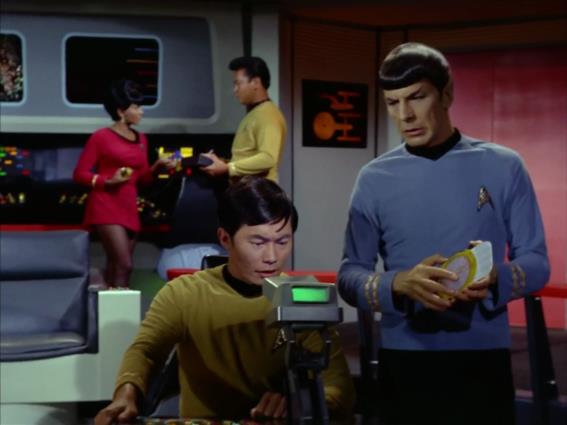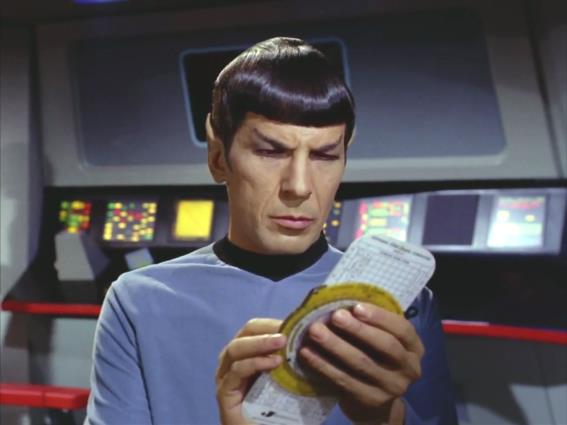
NavList:
A Community Devoted to the Preservation and Practice of Celestial Navigation and Other Methods of Traditional Wayfinding
From: Frank Reed
Date: 2023 Dec 10, 08:34 -0800
This shot of Spock using an E6B is certainly odd. The image has been copied over and over from one website to another with no hint of its specific origin. This capture is from an episode called "Who Mourns for Adonais". I made a better resolution capture of this frame from the digitally remastered episode (the remastered episodes were created from original film which the studios fortunately preserved). Probably the most amusing feature of this shot is the presence of the old Jeppesen logo --that stylized "J" at the bottom of the device.
But what "on Earth" is going on here?? What's Spock doing in the context of the "in universe" events, or in the context of the art, the melodrama of the scene? Actually, nothing at all. He doesn't manipulate the E6B device. He doesn't appear to adjust or "read" it. He just carries it around and gazes at it occasionally. Captain Kirk and others are being held prisoner on a planet they're orbiting by the Olympian god Apollo, and Spock is trying to locate and free them. Spock talks to Sulu, tells him to "reverse the polarity" (visit tvtropes.org for more on this phrase) and then he meanders around the bridge for a few seconds of tension speaking to other crew members. There's no "in universe" explanation for the handheld "calculator" he's carrying around, but here's my invention :). Spock is under enormous stress here so he is indulging one of his favorite "hobbies" to keep his emotions in check. As we all know, Spock is a fan of historical computation technology, and he has a collection [we may imagine :)] of antique computing devices. Like any good NavList member, he sometimes "toys" with those devices, manipulating the E6B provides a relief from stress. Sure, he could squeeze a rubber ball to relieve stress, but this is a Vulcan super-geek. His emotions are coiled and pressurized just beneath the surface, and he could explode at any moment! Puzzling over the E6B is keeping those emotions in check.
Separately, we can ask how this works for this episode of Star Trek as entertainment, as a work of art... In terms of the drama of the scene, viewed as art, and the symbolic purpose of the image, the very next frame in the film reveals a peaceful, idyllic lilypad pond surrounded by flowers. It's a little bit of paradise apparently created by Apollo on the planet below to impress and seduce a female crew member. The close-up on the E6B could be interpreted dramatically as an intentional contrast between analytic power and aesthetic power, right? Understand, I'm just making this shit up as I go. :)
This is not the only time an E6B or similar 1960s-era analog computing device was seen in the original Star Trek, but it is probably the last and probably the most intentional on the part of the creators of the series. This episode was from the second season. All other instances were from the very beginning of the first season and their presence in those early episodes suggests a different explanation --just props, tech-y set decoration. I'm saving that for a separate post. None of this matters, of course, yet there really is something intriguing (well, intriguing to me) here getting back to my intended topic, "sextants in pop culture". I posted some screen caps from very recent incarnations of Star Trek, all produced within the past five years, with sextants on display as decorative desk ornaments, little more than paperweights. Peter Hakel pointed out the case of the antique sextant in the captain's cabin in the revived Star Trek "TNG" c.1988 and also the case of an intentionally (in universe) "ancient" sextant (a slightly dressed-up, painted Davis Mk 15) from a later Star Trek (DS9 to fans) produced in 1995. But there was never even one sextant seen, that I can recall, in the original Star Trek produced in the 1960s. In that era handheld calculating devices, like the E6B, still appealed to some prop master as sufficiently exotic to look futuristic but sextants must have looked antique and were never shown. That tells us a little something about the cultural status of sextants in that decade.
You might think that I've exhausted the topic of navigation slide rules in Star Trek, but oh no, there's more coming. Oh no! ;)
Frank Reed









